Archive for January 2012
New Alpacas!
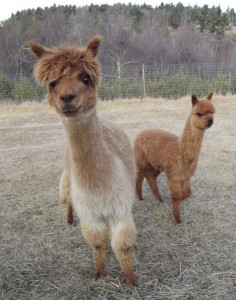
Klarice & Tebogo
We are pleased to introduce two new members of our farm, Klarice and her son Tebogo. . As we have grown over the past 6 years, we have sought to occasionally bring in new bloodlines to enhance our original herd. Klarice is a lovely, fawn, 5 year old alpaca. She is a daughter of Peruvian Pizarro’s Goldrush, who has had a long and successful show career, and Kaleen, who has Emilio in her genetic background and is known for passing on her persistently fine fleece to her offspring. . In addition to these new bloodlines, her fine fleece is the primary reason we have added Klarice to our herd. At 5 years of age, Klarice continues to have a 20 micron fleece (classified as baby alpaca fiber). She has also proven to be a great mother. Her 2009 cria, Athena Khan, has already won two first places and a color championship. . Her 2011 cria is our new Tebogo. Tebogo means “We are Thankful” in Sothos, which is a South African language. He earned this name because of an injury that occurred right after his birth. His neck was injured in a fall. He had a rough few weeks, but is thriving now and recovering well from his injury. The neck injury will keep him out of the show ring, but does not diminish the great genetics he brings to our herd. Tebogo’s herdsire is the dark rosegray, multi-color champion, Amaro Khan, son of the famous, ultra-dense, 11 time color champion, The Aga Khan. . Klarice proved her excellent mothering skills during Tebogo’s recovery. He had trouble nursing at first because of his neck injury. Klarice patiently worked with him and their previous owner to keep him strong. After Tebogo began to thrive, Klarice even assisted another cria that needed additional milk, nursing two crias like our own Ima Joy is currently doing. . To top off all these wonderful characteristics that Klarice and Tebogo bring to the herd, they are both sweet and gentle alpacas. They have beautiful, sweet faces with expressive eyes. They have both fit right into the herd. Our current crop of fall crias are particularly happy to have a new playmate. .

Therapeutic Alpaca Socks – All colors now in stock
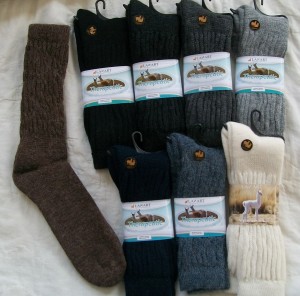
Therapeutic Socks
We just received some new alpaca diabetic socks for both men and women. These incredibly warm and soft alpaca socks are one of our most popular socks. They are designed specifically for those with diabetes or other circulatory problems. The socks come up to approximately mid-calf and have a loose fit through the top so as to not bind. Several of our customers with diabetes have told us that these alpaca socks keep their feet warmer than any other sock. A lot of people love them just because they are so soft. . We now have all colors in stock for both men and women. We’ve been out of black for men and women and navy for women, but received them today. You can see the selection at the farm or at our online store.
How We Get Our Alpaca Yarn
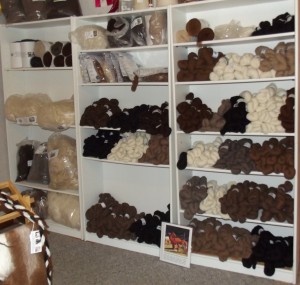
2011 Alpaca Yarns on the Shelf
The last of our 2011 alpaca yarns have arrived! These all natural, undyed, 100% alpaca yarns come from our herd of 41 alpacas raised on the Blue Ridge Parkway in Virginia. We start with a careful breeding program by selecting breeding combinations that will give us the finest and most dense fiber. Examples of the success of our breeding program are seen in Reserve Color Champion Peaceful Heart’s Lord Tennyson and his son, Tennyson’s Beckett of Peaceful Heart.
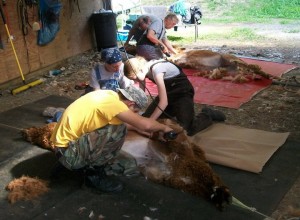
Bill shearing in the background, assisted by Mike. David shearing in the foreground, assisted by Claire & Susan Gleason.
We shear our alpacas each May. As David has gotten older, he has become our primary shearer, and does a beautiful job. We were initially trained to shear by Bill Watkins of Frostglen Alpacas, who teaches a shearing seminar for other alpaca farmers at our farm each year. The shearing method we use focuses on maximizing the quantity of useable fiber off each alpaca and keeping the three grades of fiber (blanket, neck, and legs/belly) separate as we shear.
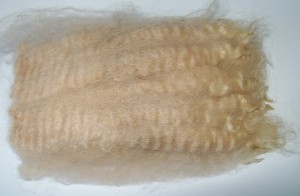
Fiber Sample from J Dubs 40
Once the fiber is off the alpaca, I sort it by color and fineness to create the best yarns possible. Alpaca fiber is sorted by the fineness of the fiber, which is measured in microns. We test a sample from all our alpaca blankets to confirm the fiber diameter for each. For reference, human hair is approximately 100 microns thick. Alpacas have been bred for their fine fiber for over 600 years, since they were first domesticated by the Incas. The fineness of the alpaca fiber is what makes it so soft and comfortable to the skin. Alpaca fiber and yarn is named by the thickness of the fibers that make up that yarn. Baby alpaca yarn is a great example, because it can be made from the fiber of any alpaca with fiber under 23 microns, no matter what their age is. The list below is a guideline for classifying the fibers, and how it relates to the yarn we make.
Classification of Fiber in Microns
- Grade 1: Royal Baby Alpaca Yarn: <20
- Grade 2: Baby Alpaca Yarn: 20-22.9
- Grade 3: Superfine Alpaca Yarn: 23 – 25.9
- Grade 4: Fine Alpaca Yarn: 26 – 28.9
- Grade 5: Medium Alpaca Yarn: 29-31.9
- Grade 6: Strong Alpaca Yarn: 32-35
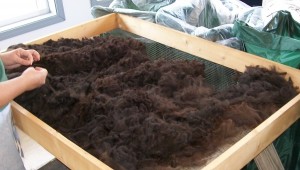
Sorting fiber from Temeraire's blanket (the baskets in the background hold the different grades of fiber as I sort)
You can see that there is very little difference between each of the grades, and proper sorting keeps the fiber that makes up a yarn more consistent. This means that all the yarns have a lovely feel. Grade 6 alpaca yarns and yarns made from our alpaca’s leg and belly fibers are best used for rugs, baskets or other items that are not worn close to the skin. The finer the grade of fiber and yarn, the softer it will feel, with the royal baby and baby alpaca yarns having the most luxurious feel. We invite you to come by the farm to get your hands on the variety of the yarns as well as our beautiful alpaca rovings.
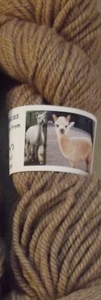 After the fiber is sorted and I decide how we would like each to be processed, I send the raw and sorted fiber to the mill. We work with a Tennesee fiber mill that processes the fiber into either alpaca rovings for spinning and felting or alpaca yarns for knitting, crochet and weaving. You can see our alpaca yarns at our online store or at the farm. I must say that they are our best yarns ever. The majority of the yarns have been done in a 3 ply worsted weight and they all have an incredible feel. Have fun knitting, crocheting and weaving.
After the fiber is sorted and I decide how we would like each to be processed, I send the raw and sorted fiber to the mill. We work with a Tennesee fiber mill that processes the fiber into either alpaca rovings for spinning and felting or alpaca yarns for knitting, crochet and weaving. You can see our alpaca yarns at our online store or at the farm. I must say that they are our best yarns ever. The majority of the yarns have been done in a 3 ply worsted weight and they all have an incredible feel. Have fun knitting, crocheting and weaving.

Alpaca Crias Playing
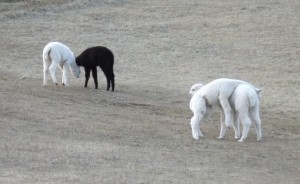 Alpaca crias love to play and we love to watch them. There is nothing more fun than looking out the window to see alpaca crias pronking through the pasture or wrestling.
Alpaca crias love to play and we love to watch them. There is nothing more fun than looking out the window to see alpaca crias pronking through the pasture or wrestling.
 We have observed that the girls tend to be runners, and love to get everyone pronking and then will take off running as fast as they can, leaving the boys behind. It is great exercise for them and they even occasionally get their moms running around the pasture with them. I keep trying to get a good video or pictures of the crias pronking, but so far the best I’ve done is the recent video I placed on Facebook.
We have observed that the girls tend to be runners, and love to get everyone pronking and then will take off running as fast as they can, leaving the boys behind. It is great exercise for them and they even occasionally get their moms running around the pasture with them. I keep trying to get a good video or pictures of the crias pronking, but so far the best I’ve done is the recent video I placed on Facebook.
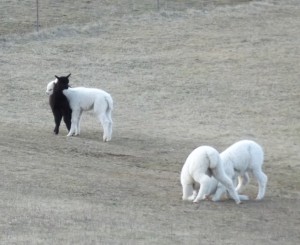 Our boy alpaca crias will happily run and pronk with the girls, but they love to wrestle. The other day, I caught our fall crias having a great time wrestling. Obsydyan (born Oct 28) and Timbuctoo (born Oct 18) are to the left, and Lightening Bolt (born Sept 14) and Sunspot (born Sept 26) are to the right.
Our boy alpaca crias will happily run and pronk with the girls, but they love to wrestle. The other day, I caught our fall crias having a great time wrestling. Obsydyan (born Oct 28) and Timbuctoo (born Oct 18) are to the left, and Lightening Bolt (born Sept 14) and Sunspot (born Sept 26) are to the right.
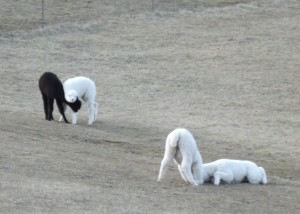 Alpaca crias will wrestle and nip at each others’ feet until one of them pins the other down. Then they usually jump right up and start all over again.
Alpaca crias will wrestle and nip at each others’ feet until one of them pins the other down. Then they usually jump right up and start all over again.

Thank You
Thank you to everyone for your kind words about the loss of Tequila and Obsydyan’s adoption by Ima Joy. We have been touched by the facebook posts, emails, and cards expressing your sympathy and telling about your interactions with Tequila. She was very special to us. It has been special to learn how others were touched by her too.

Happy Endings – Adopted cria

Syd, after he had decided bottles were a good thing.
We started with the bottle right away to make sure he had sufficient nutrition. We keep Wombaro alpaca milk replacer on hand as well as a bottle with a Pritchard nipple ready in case we need to supplement a cria as they are getting on their feet. We’ve never had an orphaned cria before or needed to start supplementing an older cria so were worried he would not take the bottle. Alpaca crias, unlike some other young livestock, do not like to drink from bottles and can be a challenge to get to hold still, take the bottle in their mouth, and even to get to swallow. Patience (and Syd being hungry) got us past those hurdles, and he began to take some milk. He seemed to like it even more when our vet, Heather Jenkins at Healing Springs Animal Hospital, suggested we try fresh brown swiss cow’s milk. She had worked with alpacas in Peru for several weeks last January, and had observed alpaca crias thriving on this high fat milk. Syd began willingly drinking a couple bottles a day of 8-12 ounces. . Our next task was to find Syd an adoptive mother. Alpacas tend to not let other crias ‘steal milk’ and will fuss at other crias for trying. I had hope that our sweetest tempered alpaca, Ima Joy who had a cria just two weeks before Syd was born, might take him on. I immediately put Ima, her cria Angelica (born Oct 16), and Syd (born Oct 28) into my small fenced in garden next to the house. We set up one of our tents we use for fairs so they’d have a roof to get under. Ima would let Syd nurse if I stood and held her gently, but since she already had a cria she was nursing I had a couple other ideas to try. The day after Syd was orphaned (Tequila died in the late afternoon right as the sun was setting), we were weaning the last of our spring crias. Thinking that one of the mothers might take on the new cria when we moved her boy into the weanling pasture, we tried to get the mothers to let Syd nurse. Syd was willing to try, the moms, not so much. Ruthie cushed every time Syd would come near. Fran bumped him with her knee and would not let him approach. . After multiple tries, we decided that Ima Joy was our best bet. Her sweet temperament allowed her to stand still as Syd nursed, initially with us holding her several times a day, and eventually without us needing to be near. I knew she had decided to adopt Syd when I looked out the window one night and saw Ima Joy nursing both Syd and Angelica at the same time.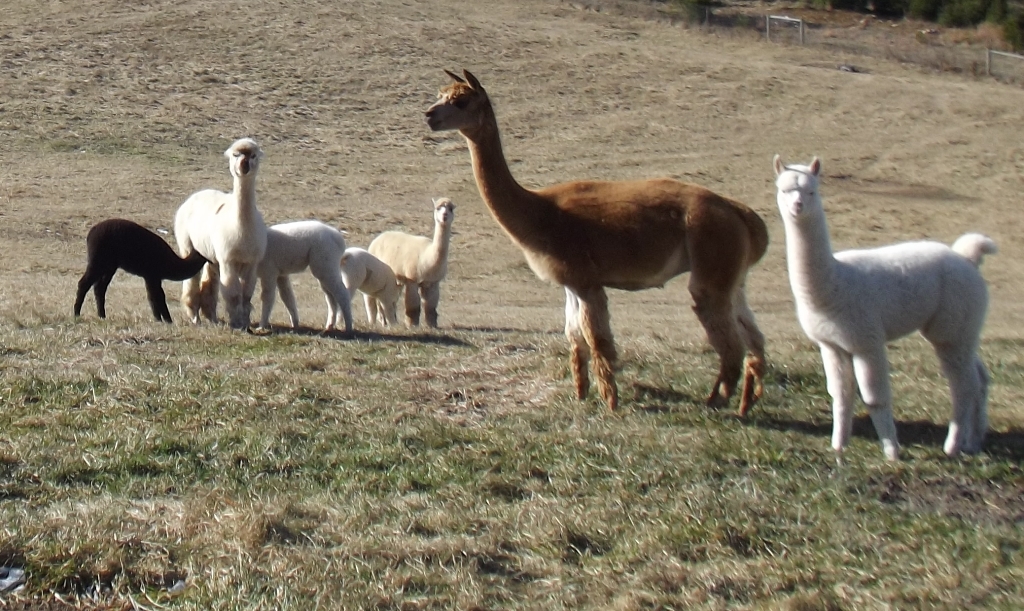
Syd and Angelica with Ima Joy, nursing at the same time (Sunspot and Sunny in the background; Lystra and Lightening Bolt in the foreground)
I am so happy to report that Syd is thriving. He is nursing, taking a bottle a day (he is not near as excited about bottles now), and eating grain and alfalfa pellets for extra energy. Ima enjoys her extra rations too, which help her as she produces extra milk for Syd. Syd and Angelica are both gaining weight, and I love to see this new little family snuggle up at night. They stick close during the day as they roam with the other mamas and crias looking for winter grass.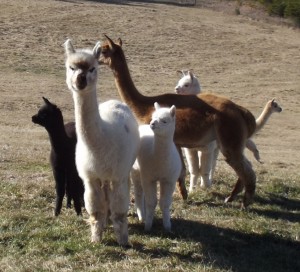 A sad story, with a very happy ending.
A sad story, with a very happy ending.

The hard part of alpaca farming
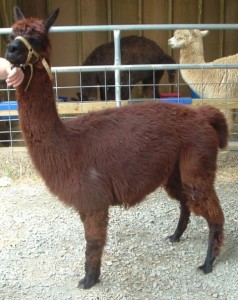 We bought our first alpacas in October 2005. We had decided to start raising alpacas and after spending time researching alpacas, we found Tequila and her cria Sensational Mahogany. Tequila has given us three beautiful boys, including Sensational Mahogany, Caramelo, and most recently Obsydyan, and three fabulous girls, Henrietta Ruth, Sugar Cookie, and The Black Pearl. These beautiful alpacas range in color from pale fawn to true black.
.
We lost Tequila on Dec 13, 2011. She was 17 years old and had given birth to 13 alpacas in her lifetime. Tequila provided an excellent foundation for our herd. She had a persistently fine fiber which she has passed on to her daughters who are now producing fabulous crias of their own.
.
We bought our first alpacas in October 2005. We had decided to start raising alpacas and after spending time researching alpacas, we found Tequila and her cria Sensational Mahogany. Tequila has given us three beautiful boys, including Sensational Mahogany, Caramelo, and most recently Obsydyan, and three fabulous girls, Henrietta Ruth, Sugar Cookie, and The Black Pearl. These beautiful alpacas range in color from pale fawn to true black.
.
We lost Tequila on Dec 13, 2011. She was 17 years old and had given birth to 13 alpacas in her lifetime. Tequila provided an excellent foundation for our herd. She had a persistently fine fiber which she has passed on to her daughters who are now producing fabulous crias of their own.
.
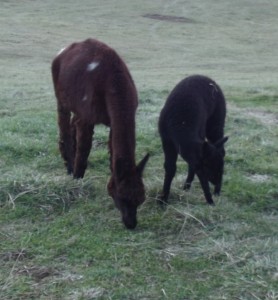
Tequila and Obsydyan, Dec 12, 2011
Losing Tequila was hard, but unfortunately raising livestock of any kind will occasionally come with loss. We’ve been blessed to not lose any of our alpacas before this year, but we were prepared that it would happen at some time. Tequila died peacefully of old age (alpacas live an average 15-25 years). She was out grazing a few hours before we found her. The hardest part about losing Tequila was the fact that she was still nursing a six week old cria at the time of her death. . Obsydyan was Tequila’s last cria. He was a good size, 33 pounds, when she died, but still nursing and very much in need of his mother. It was heart breaking to see him look for her after she was buried. Our first priority was to take care of Obsydyan. Alpaca crias are not anxious to take milk from a bottle, even when they are little. We were concerned about trying to get Syd to begin drinking from a bottle, but started working with him on that and then started to see if we could get one of our other alpacas to adopt him. Read on for the very happy ending to the story.